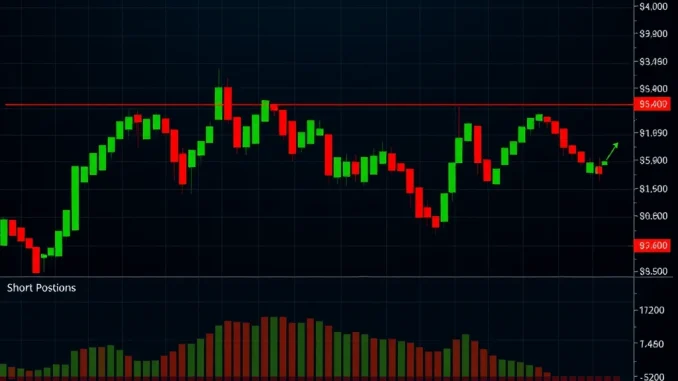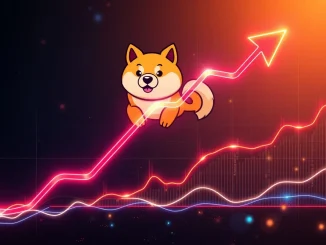
Ever wondered what the smart money is doing in the crypto markets? One powerful indicator savvy traders keep a close eye on is the BTC long-short ratio. It’s like peeking behind the curtain to see whether the majority are betting on Bitcoin going up (long) or down (short). Today, we’re diving deep into the latest 24-hour snapshot of these ratios for Bitcoin perpetual futures across leading cryptocurrency exchanges. Are traders feeling bullish or bearish? Let’s uncover the answer.
Decoding the 24-Hour BTC Long-Short Ratio: What’s the Sentiment?
The overall picture for BTC perpetual futures across all tracked exchanges in the last 24 hours paints an interesting scenario:
- Total Exchanges: Long positions hold 48.84% while Short positions slightly edge ahead at 51.16%.
At first glance, this suggests a slightly bearish sentiment prevailing in the broader market. A higher percentage of short positions indicates that more traders are betting on a potential price decrease in Bitcoin. However, the difference is quite narrow. Let’s break down the data further by examining the top three exchanges to gain a more granular understanding of crypto market sentiment.
Binance, OKX, and Bybit: Exchange-Specific Insights into BTC Futures Trading
Looking at individual exchanges can reveal nuances in trader positioning. Here’s a breakdown of the exchange long-short data from the top players:
| Exchange | Long Positions | Short Positions |
|---|---|---|
| Binance | 48.76% | 51.24% |
| OKX | 47.55% | 52.45% |
| Bybit | 47.95% | 52.05% |
As you can see, across all three major exchanges – Binance, OKX, and Bybit – short positions are slightly dominating long positions. This consistent trend across these platforms reinforces the idea of a marginally bearish sentiment in the BTC futures trading arena over the last 24 hours.
Why is the BTC Long-Short Ratio Important for Traders?
Understanding the BTC long-short ratio offers several key benefits for cryptocurrency traders:
- Gauge Market Sentiment: As we’ve seen, the ratio provides a direct snapshot of whether traders are leaning bullish or bearish on Bitcoin. This can be invaluable for anticipating potential price movements.
- Identify Potential Overextension: Extreme long or short ratios can sometimes signal market overextension. For example, a very high long ratio might suggest the market is overly bullish and ripe for a correction. Conversely, an extremely high short ratio could indicate oversold conditions and a potential bounce.
- Confirmation Signal: The long-short ratio can be used as a confirmation signal alongside other technical indicators or fundamental analysis. If your analysis suggests a potential downtrend, a rising short ratio could strengthen your conviction.
- Risk Management: By understanding market sentiment, traders can better manage their risk. For instance, if the market is heavily long, a trader might consider reducing their long positions or tightening their stop-loss orders.
Challenges of Relying Solely on Long-Short Ratios
While insightful, it’s crucial to remember that the BTC long-short ratio is just one piece of the puzzle. Here are some challenges to consider:
- Exchange Specificity: Ratios can vary between exchanges. Focusing on a single exchange might not provide a complete picture of the overall market sentiment. That’s why looking at aggregated data across multiple top exchanges, as we’ve done here, is more beneficial.
- Lagging Indicator: Long-short ratios are often considered a lagging indicator, reflecting past positioning rather than predicting future price movements with certainty. Market conditions can change rapidly, and ratios can adjust accordingly.
- Whale Influence: Large traders (whales) can significantly impact these ratios. A few large short positions, for example, can skew the overall ratio towards bearish, even if the majority of smaller traders are long.
- Not a Trading Signal in Isolation: It’s generally not advisable to base trading decisions solely on long-short ratios. They should be used in conjunction with other forms of analysis, such as price action, volume, and fundamental news.
Actionable Insights for Crypto Traders
So, how can you use this exchange long-short data effectively?
- Monitor Regularly: Keep an eye on these ratios daily or even intraday, especially during periods of high market volatility.
- Compare Across Exchanges: Look at ratios across multiple exchanges to get a broader view of market sentiment.
- Combine with Other Tools: Integrate long-short ratio analysis with your existing trading strategies and technical analysis.
- Stay Informed: Keep up-to-date with news and events that could influence market sentiment and, consequently, long-short ratios.
Conclusion: Navigating Crypto Markets with Sentiment Insights
The 24-hour BTC long-short ratio snapshot reveals a slightly bearish sentiment in the Bitcoin perpetual futures market. While not a definitive predictor of price movements, this data provides valuable insights into trader positioning and overall crypto market sentiment. By understanding and monitoring these ratios, alongside other analysis tools, you can enhance your understanding of market dynamics and make more informed trading decisions in the ever-volatile world of cryptocurrency. Remember to use this information as one piece of your comprehensive trading strategy and always manage your risk effectively.



